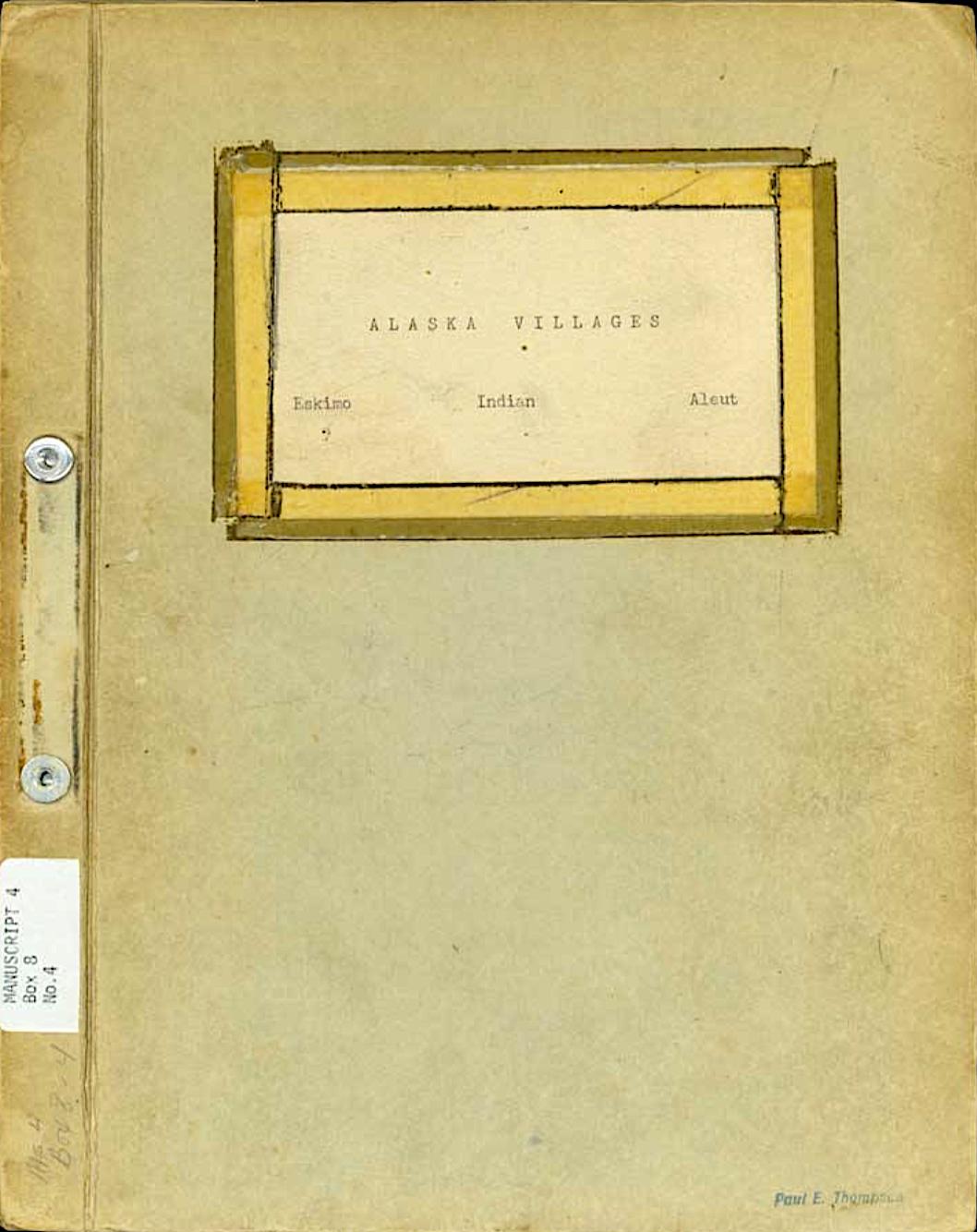
4 minute read
Alaska Villages, 1937
Top: Main school building at Eklutna. [Photo by Walter W. Hodge, Univ. of Alaska Fairbanks, Walter W. Hodge Papers, ca. 1925-1948. UAF-2003-63-61]
Eskimo, Indian, Aleut, 1937
Advertisement
From Students at Eklutna Vocational School during 1937
At the Alaska State Library online archive is a photograph of the cover of a manuscript with descriptions of 58 Alaskan villages by various students attending the Eklutna Vocational School. Available to read online, it was assembled in the Fall of 1937 by Paul E. Thompson, who went to Ektutna Vocational School as a teacher and spent summers at the Knik Arm fish camp for the school.
The villages described by the students include Afognak, Alitak, Anvic, Attu, Barrow, Beaver, Bethel, Cantwell, Chignik, Circle, Diomede, Eagle, Egegik, Elim, Flat, Fortuna Ledge (Marshall), Fort Yukon, Galena, Haycock, Karluk, Kenai, King Cove, Kivalina, Kokrines, Kotzebue, Koyuk, Koyukuk, Long Beach, Manley Hot Springs, Metlakatla, Nash Harbor, Neelik, Noatac, Nome, Noorvik, Nulato, Nunapitchuk, Perryville, Pilot Point, Pilot Station, Point Hope, Point Lay, Rampart, Ruby, Selawik, Shishmaref, Snag Point, Stevens Village, St. Mark's Mission, Tanana, Tatitlek, Teller, Unalakleet, Unalaska, Wainright, White Mountain, Wiseman, and Yakutat.

Cover of Thompson’s manuscript, available to read online. [Alaska State Library, ASL-MS4-08-004]
Paul E. Thompson went to Cordova in 1931 as a warden for the U.S. Bureau of Fisheries, and returned to Cordova each year as a seasonal fish warden through 1937, when he went to Eklutna. In spring, 1941 he went to Juneau as District Chief for the U.S. Fish and Wildlife Service, until February 1942 when he transferred to Washington, D. C. as assistant chief for the Division of Alaska Fisheries. Mr. Thompson retired from the U.S. Fish and Wildlife Service as Chief of Fishery Research in March, 1971, and moved to Alexandria, Virginia.
Paul Thompson’s photograph collection in the Alaska State Library contains black and white photographs of adolescent students and student activities at the Eklutna Vocational School, where he taught during the late 1930’s, and most of the students are identified. The photo collection is not available online, but the manuscript is. A few excerpts:
• Afognak: My home is located among the first islands on the Aleutian chain, on Afognak Island, near Kodiak. It is on the coast so that means there are lots of boats that travel back and forth, some from outside and others from almost all parts of Alaska from Seward to Unalaska. Our only way of travel is by boats. For a living the men fish in the summer and hunt in the winter.
• Circle is up along the Yukon River; it isn't a very big town, with a population of about 100 people. In the winter the weather is so cold that the thermometer sometimes goes down as far as 70 below or more. In the summer it doesn't get so very hot—only once in a while. It rains and blows a good deal in the summer.
• Fortuna Ledge, or Marshal [Marshall], as it is generally called, is located on the Yukon River about one hundred miles from the mouth or this mighty river. Traveling is done by boat, dogteam or airplane. The latter is used mostly for long distance traveling in winter. The dogs play a great part in carrying our mail from St. Michael after the Yukon has frozen.
• The small rather thickly populated town of Ft. Yukon is situated on the Yukon River. It faces the river and is flat and unprotected from wind due to the mountainless scenery. The winter is extremely dry and cold but undaunted the majority of the male populace goes ahead with the fur trapping, hunting, woodcutting and hauling. The young people in the meantime attend school.
• Kivalina is located on a little island surround, by the ocean and a lake. The climate is very cold in the winter—down to 60 below in the winter around January; it never seems to get so warm there as it does at Eklutna. Travel is mostly done by dogteam in the winter and boats in the summer. In summer when the men are inland where they are rounding up the reindeer, they have to walk on foot for miles.
• If you were looking for Kokrines you would look between Ruby and Tanana. There are hills almost all around it. The town itself is built on a big hill. It is about 402 miles from Eklutna. There are about 98 people in Kokrines. They cut wood for the steamboats, traders, school , and Northern Commercial Company down at Ruby. They sell dried fish, meat, all kinds of berries, moccasins, boots, and many other things to earn money.
• Noorvik: In the winter the people work and hunt for a living. The women cook, make mukluks, parkas and mittens. They use wood for fuel instead of coal. In the Spring nearly all the people scatter out for their muskrat camps and hunt for the next three months. In summer they move to their fishing camps and fish for smelts, sheafish, white fish, pickerel, mudsharks, trout and salmon. The most important fish are the salmon and the whitefish. They sell these to the traders and get what they need in exchange. Most of the time the women pick berries and store them away for the winter. ~•~
Manuscript: http://library.state.ak.us/hist/fulltext/ASL-MS-0004-08-004.htm







